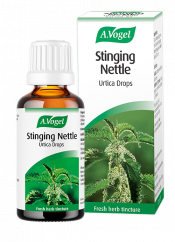What is a low histamine diet?
When it comes to hayfever and allergies, histamine is often perceived to be the primary enemy, the trigger for the majority of symptoms that occur. However, histamine in and of itself isn’t a bad thing and is actually pretty important when it comes to your immune response. For example, histamine helps to widen your blood vessels, allowing white blood cells access to the affected area quickly so they can deal with any injuries, infections or pathogens more efficiently.

Unfortunately, in the case of allergies though, this reaction can be complicated; for a start, your immune system isn’t actually responding to a threat, instead, it’s reacting to harmless substances such as pollen, animal dander or dust. Once it’s identified these innocent particles as the enemy, your mast cells (which are located all over your body, including your skin, stomach and connective tissues) will release excessive amounts of histamine which in turn encourages inflammation and the production of mucus, leading to many of the tell-tale allergy symptoms you’re familiar with.
Avoiding or lowering histamine levels is naturally a priority then for many hayfever sufferers. This is where your diet comes into the picture as many different foods either contain histamine or can encourage its proliferation. The last thing you want in the midst of a particularly bad bout of hayfever is to exacerbate your symptoms by eating the wrong foods. This has led many to seek out low histamine diets, avoiding or completely boycotting some foods that contain this chemical compound.
Which foods contain histamine?
- Fermented foods: kombucha, sauerkraut, aged cheese, yoghurt, sour cream
- Cured meats: sausages, salami, smoked ham, bacon
- Canned fish: salmon, mackerel, tune
- Vinegar
- Pre-packaged ready-meals
- Legumes: chickpeas, soybeans, lentils
- Spinach
Which foods can encourage histamine?
- Citrus fruits: lemons, limes, grapefruit
- Additives
- Preservatives
- Tomatoes
- Alcohol
As you can see from the list above, there is an extensive range of foods that have the potential to increase our levels of histamine. This is why one of the major problems associated with embarking on a low histamine diet is developing a nutrient deficiency. Therefore, low histamine diets are generally only recommended if you suspect you have a histamine intolerance, rather than if you suffer from an allergy such as hayfever.
So, what can you do if cutting histamine completely out of your diet is off the table? Well, while I’m not a big fan of completely eliminating certain food groups unnecessarily, if you do find yourself struggling during the allergy season then perhaps you could try including more foods with natural antihistamine and anti-inflammatory properties to help tackle all the excess histamine circulating through your body.
What foods are good antihistamines?
1. Garlic

It’s often recommended you stock up on garlic during cold and flu season but adding a little more of this pungent-smelling herb to your diet during the hayfever season could be very beneficial too. Not only is garlic rich in vitamin C, a potent antihistamine nutrient, it also contains a special compound called ‘quercetin.’ Quercetin, like vitamin C, acts as a natural antihistamine agent, plus it helps to eliminate scavenging free-radicals which can damage your immune system. Garlic also contains an additional histamine-busting component called allicin which acts as a natural decongestant helping to ease blocked, stuffy noses.
My top tip: Garlic can be easily added to soups and stews but if you’re after a more summery meal that contains a decent amount of garlic, you could try this recipe for Baked Garlic Ravioli, served with a light, crisp side salad.
2. Ginger

Similar to garlic, ginger is another food that often gets mentioned during the winter seasons but is perhaps best known for its anti-nausea properties. However, ginger can also work as a natural anti-inflammatory, helping to ease some of the swelling associated with allergies – research even backs this benefit up as a 2015 study, published in Allergic Diseases – New Insights, found that ginger capsules were able to reduce each participant’s hayfever symptoms quite significantly, tackling sneezing and sinusitis.1 That’s why it’s included in our Hayfever Blasting Smoothie!
Simple swaps: Why not swap your cup of caffeinated tea for a spicier blend? Caffeine can stimulate the production of histamine, plus the milk usually found here can promote the secretion of mucus, blocking your nasal passages. Ginger tea, on the other hand, has natural antihistamine properties and could actually help to ease blocked, stuffy noses.
3. Pineapples

Sweet and exotic, pineapples are definitely a popular fruit to have on standby when the weather finally starts to heat up; not only do they taste great though, pineapples are an incredibly rich source of vitamin C. As I’ve already mentioned, vitamin C is a key nutrient when it comes to combating histamine (if you don’t believe me, just check out our Allergy Advisor Louise’s blog ‘7 nutritional tips to help you survive the hayfever season'). However, pineapples aren’t just great sources of vitamin C; they also contain a potent anti-inflammatory compound, Bromelain, which could help to reduce swelling.
My top tip: Pineapples are a lovely addition to your diet during the warmer spring and summer months. I like to use them in fruit salads but over on our recipe hub, I found a delicious recipe for Pineapple Ice Lollies that you might want to try too!
4. Salmon

Salmon? But didn’t I already mention that canned fish are a major dietary source of histamine? Well, yes, but there should be some emphasis on the word canned here. Fresh, oily fish such as salmon may actually help in the case of allergies such as hayfever as they’re rich in omega-3 fatty acids. This particular type of fatty acid can be extremely beneficial as they can help to reduce inflammation, a major cause of hayfever symptoms. The right balance of omega-3 fatty acids can also help to regulate your levels of omega-6, a pro-inflammatory fatty acid often found in fatty, fried foods.
My top tip: Including oily fish in your diet is all well and good if you’re happy to eat meat but if you’re vegan or vegetarian then you’re sources may be more restricted. However, you can still find omega-3 in plant-based sources such as chia seeds, hemp seed oil, nuts such as walnuts and flaxseeds.
5. Turmeric

I’m sure that by now most of you have heard of turmeric; this super-spice started to take the world by storm a couple of years ago and now it’s everywhere, from coffee shops to high street shelves. The reason why this spice has won so much acclaim is largely due to a compound it contains called curcumin. A natural anti-inflammatory agent, curcumin can also act as an antioxidant, combating free-radical damage. When it comes to pollen allergies, studies have found that curcumin may be useful in easing nasal symptoms such as congestion and sneezing.2
My top tip: Turmeric supplements are all the rage these days but, ideally, little and often are the way to go. That’s why adding more turmeric to your cooking might be a good idea. There are plenty of recipes for you to choose from here – why not try this warming recipe for a Coconut, Spinach and Red Lentil Dhal.
6. Stinging nettle

Last, but definitely not least, stinging nettle! This might not sound like a particularly appealing entrant on this list, but stinging nettle more than earns it place here. This plant has potent anti-inflammatory properties and may actually help to relieve symptoms such as redness, irritation, runny nose and sore eyes. As much as some claim that rubbing the plants on your skin can help, I would definitely NOT advise going through with this method of application. Instead, you might be better trying a few cups of nettle tea or investing in a herbal remedy such as our Urtica Drops.
My Top Tip: This therapeutic herb can help to ease a range of complaints, from prickly heat rash to improving the quality and appearance of your hair. This therapeutic herb can help to ease a range of complaints, from prickly heat rash to improving the quality and appearance of your hair.
|
Can honey help with allergies?
When it comes to hayfever-fighting foods, local honey is one that’s recently entered a lot of people’s radars. However, whether or not this food product can actually help is up for debate and, as of yet, there is no clear answer either way. If you want to learn more about some of the key points surrounding this debate, I suggest checking out Louise’s blog, ‘Can honey help hayfever?’





 Looking for our products in a store near you?
Looking for our products in a store near you?

